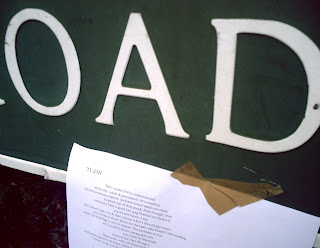By June 1997 Michael Weller became totally pissed off with politics, management committees, general meetings, mass demonstrations and local left-wing activism in Tory London borough of Bromley.
Here's the story. It's a June 1997 "tale from wellerverse". Mike is broke and feeling unWeller. He'd wasted an entire decade as a militant socialist fighting emergent neoliberalism. In the tale Mike Weller felt he was ending the century a deadbeat loser, his vision artfully impaired by the Earth Corporation. Clinicians at "Maydie" (local 20c folk term for old Croydon hospital) sketched the backs of character Weller's badass eyes copied from their digital scans.
"We are the street artists now--not you eye fuck!" the mind-pickers pathed.
Weller thought "surely I must be in some fiction where God creates Weller as an artist got rotten by Satanic possession of his mojo". For in novelist MJ's tetralogy character Mike Weller is rewarded by The Devil—not that old clich
éd Robert Johnson soul-at-the-crossroads-deal illustrated. This deal was lose colour field vision—win black-and-white-inner vampire vision.
Theme for a comic space opera? Weller immersed himself writing and drawing. Planned since 1986 from notes and sketches in Weller's 'folders-full-of-Mick', this was going to be a comic-book series to finish the twentieth century off good and ill.
1997 in general was proving itself a year of escape from eighteen years Tory rule. Mass escapist counterculture ruled the roost. Characterized by emergence pop heroes Harry Potter, Buffy the Vampire Slayer, Mulder, Scully etc, along with comic books turned into slick graphic novels and popcorn-munching Marvel and DC comic superhero movies animated musical background Mel C's and B's, Brand New Heavies, All Saints 'n' hip hop cold rock a party in b-girl stance-fu-gee-la-la-land Britpop one-time. As old and fake as Weller's "Earth Corporation Millennium Glory Glory Temple".
Myth, magic, fantasy fun and conspiracy mêlée.
Mike Weller's Space Opera 'zines were completed 1999.
'The Truth Is Out There' became the X-Files' strapline.
The real
twentieth century ended September 11 2001. From then on conspiracy and
fake news became new populist counterculture. Conspiracy theory as counterfeit reality. Weller documented that story 2001-2010 as prose
Slow Fiction. June 1997's "Vampire Empire" fitted a late 90's milieu—familiarised as a cartoon glove fashioned by old commercial artist character Sid Muddleton's illustrated line model feigned as Mike Weller's first professional comic book inking job 1965.
In the late 90s Tory Bromley got literary with its own Scribblers rebel band of local writers. Socially-oriented Beckenham scribblers found art, comedy, music, reading and publishing spaces with Lottery-funded Studio at 28 Beckenham Road. Weller got social. But number twenty-eight Beckenham Road was exactly the same location Weller began secondary Technical school in 1957. Coincidentally the Scribblers reading room was the classroom forty years before when Beckenham Technical School's subaltern head of English christened Michael Weller "Sam" to his class of thirty boys. Michael John Weller was transformed into Dickens' character Sam Weller ready-written 19th century. No sweat. His 20th century space opera needed to find a way out of time-and-space bound fixed identities. Turn fiction into tales-within-tales. Graphic entertainment.
3World x 4 dimensions = 12 space opera tales. Beckenham characters drawn from Weller's life since 1957 made fictional against backbeat pre-EEC English working class pop stars 1958-1962.
Please Don't Tease
audiences Continental, Nordic, Soviet Union, Eastern Europe, South Africa (early '60s) and the Commonwealth nations. Tinny 45rpms with colourful record labels -- soundtrack to atomic threats, strontium-90, cold war crises, crumbling domestic Toryism and asbestos-ridden prefabricated housing.
The Prefabs returned in 1997 for a space opera. Weller put four once-famous Brit pop stars into an imagined pre-globalized beat group: its young one trad dad film actors playing made-up Eduard Mogilowski superheroes Cosmic Crusaders in parallel earth 1966 comic. Illustrated by fictional Mike Weller. Comic-book plotted as a millennial end times conflict between a globalized Jesus Christ of Marian catholics, Protestant evangelicals and an evil, invisible, possessive Duke of Hell sampled as Satan from Milton's poetic universe.
note: a shorter version of this post is testing @HomeBaked's digital blog http://www.homebakedbooks.uk/myspace-opera1










